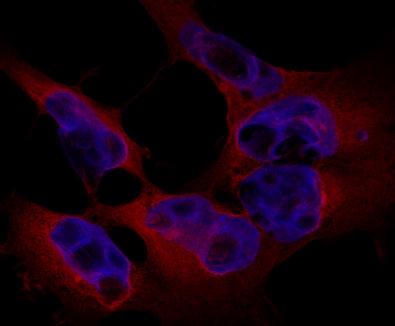German Research Foundation approves new collaborative research center on selective autophagy

Upon the induction of selective autophagy, proteins prone for degradation are initially gathered around the cell nucleus. photo: Jana Renziehausen, Institute of Pathobiochemistry, Mainz University Medical Center
The German Research Foundation (DFG) will be providing approximately EUR 11 million over the next four years to fund a new collaborative research center on autophagy.
Scientists from the Mainz University Medical Center as well as from the Institute of Molecular Biology (IMB) are part of the research consortium. Autophagy is an important cellular process that is involved in energy production, cellular stress response, and immune reactions. The goal of the new research center is a better understanding of autophagy at the molecular and cellular level.
The researchers trust that they will be able to impact autophagy processes in the future in order to treat various forms of cancer, neurodegenerative disorders, infectious diseases, and inflammatory reactions more effectively. The center will be managed under the aegis of Goethe University Frankfurt.
“This new research center, in which the University Medical Center of Johannes Gutenberg University Mainz is involved, demonstrates the enormous research potential of the universities in the Rhine-Main region. The collaboration underlines how pioneering work can be undertaken when outstanding scientists from the region work together to develop collaborative research projects,” said Professor Ulrich Förstermann, Chief Scientific Officer of the Mainz University Medical Center.
Autophagy occurs in organisms as simple as yeast cells and as complex as human beings. It is through this process, for example, that protein aggregates are degraded that can cause severe damage in cells and can lead to cell death as it is observed in several neurodegenerative disorders.
Even entire cellular organelles can be removed by autophagy when they do not function properly any longer and viruses or bacteria that invade cells can be neutralized. The components recovered in the process can then be reused by cells as basic material, which is why autophagy is also employed as a strategy for cell survival when the energy supply is low. Autophagy represents an extremely complex and precisely regulated process that depends on the coordination of many players.
The degradation-prone substrate at first is specifically recognized and then enclosed by a membrane, which matures into a so-called autophagosome. This structure then fuses with larger cell organelles, the lysosomes that are filled with digestive enzymes and break the contents down to single building blocks.
“It has long been thought that autophagy represents an unspecific process. As it has become increasingly clear that the cells can target the process and that its disturbance is associated with an entire series of disorders, autophagy research has really taken off,” explained Professor Christian Behl, Deputy Speaker of the CRC and Director of the Institute of Pathobiochemistry at the Mainz University Medical Center. “Many questions are still awaiting answers. We need to determine, for example, how exactly this process is regulated and modulated and how it is linked to other cellular mechanisms.”
It is now known that autophagy is particularly dependent on the cellular context. By controlling various cellular components, it is able to prevent the formation of cancer cells. On the other hand, cancer cells make use of autophagy processes in order to survive the nutrient shortage associated with fast tumor growth.
Less research has been done on the interplay of autophagy with other mechanisms, such as the intake of substrates by the invagination of the cell membrane (endocytosis), programmed cell death (apoptosis), and the ubiquitin system, which marks proteins for degradation by the proteasome.
Within the new collaborative research center, scientists are planning to investigate autophagy at the molecular, cellular, and model organism level. It is the first large-scale collaborative project on this subject to be undertaken in Germany and enables the Frankfurt- and Mainz-based scientists to strengthen their position in a highly competitive international field.
For it, a broad setup across several disciplines is required and thus the network brings together structural biologists, biochemists, cellular biologists as well as clinicians. The results on molecular mechanisms will be directly assessed within model systems of human diseases.
In Mainz, in addition to the Institute of Pathobiochemistry at the Mainz University Medical Center the Institute of Molecular Biology (IMB) is involved. Partners in Frankfurt include various departments of Goethe University Frankfurt, e.g., Life Sciences, Biochemistry, Chemistry, Pharmaceutical Sciences, and Medicine, along with the Buchmann Institute for Molecular Life Sciences and the Georg-Speyer-Haus.
Contact:
Professor Dr. Christian Behl
Institute of Pathobiochemistry
University Medical Center of Johannes Gutenberg University Mainz
Duesbergweg 6
55128 Mainz, GERMANY
phone +49 6131 39-25890
fax +49 6131 39-25792
e-mail: cbehl@uni-mainz.de
http://www.unimedizin-mainz.de/pathobiochemie/home.html?L=1
Press contact
Oliver Kreft
Press and Public Relations – Mainz University Medical Center
phone +49 6131 17-7424
fax +49 6131 17-3496
e-mail: pr@unimedizin-mainz.de
http://www.unimedizin-mainz.de/home.html?L=1
http://www.uni-mainz.de/presse/19947_ENG_HTML.php – press release
Media Contact
All latest news from the category: Life Sciences and Chemistry
Articles and reports from the Life Sciences and chemistry area deal with applied and basic research into modern biology, chemistry and human medicine.
Valuable information can be found on a range of life sciences fields including bacteriology, biochemistry, bionics, bioinformatics, biophysics, biotechnology, genetics, geobotany, human biology, marine biology, microbiology, molecular biology, cellular biology, zoology, bioinorganic chemistry, microchemistry and environmental chemistry.
Newest articles

Combatting disruptive ‘noise’ in quantum communication
In a significant milestone for quantum communication technology, an experiment has demonstrated how networks can be leveraged to combat disruptive ‘noise’ in quantum communications. The international effort led by researchers…

Stretchable quantum dot display
Intrinsically stretchable quantum dot-based light-emitting diodes achieved record-breaking performance. A team of South Korean scientists led by Professor KIM Dae-Hyeong of the Center for Nanoparticle Research within the Institute for…

Internet can achieve quantum speed with light saved as sound
Researchers at the University of Copenhagen’s Niels Bohr Institute have developed a new way to create quantum memory: A small drum can store data sent with light in its sonic…





















